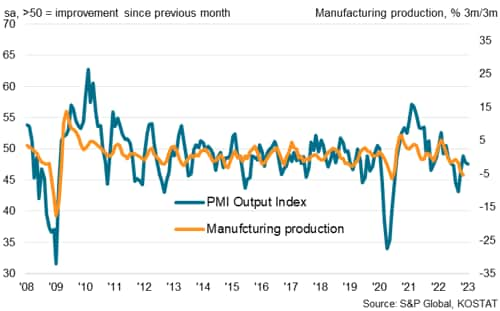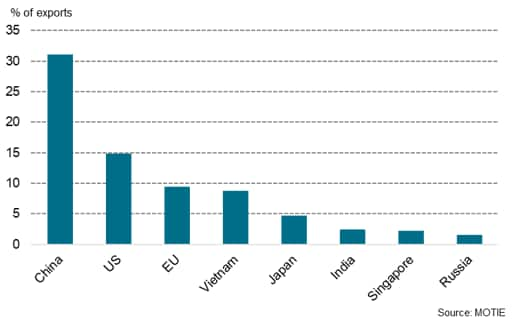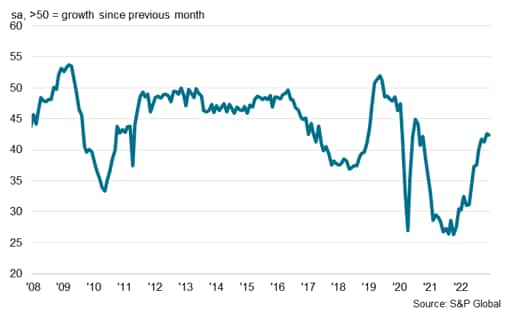Featured Topics
Featured Products
Events
S&P Global Offerings
Featured Topics
Featured Products
Events
S&P Global Offerings
Featured Topics
Featured Products
Events
S&P Global Offerings
Featured Topics
Featured Products
Events
Financial and Market intelligence
Fundamental & Alternative Datasets
Government & Defense
Banking & Capital Markets
Economy & Finance
Energy Transition & Sustainability
Technology & Innovation
Podcasts & Newsletters
Financial and Market intelligence
Fundamental & Alternative Datasets
Government & Defense
Banking & Capital Markets
Economy & Finance
Energy Transition & Sustainability
Technology & Innovation
Podcasts & Newsletters
ECONOMICS COMMENTARY — Feb 03, 2023

By Rajiv Biswas
The South Korean economy slowed significantly during the second half of 2022, with GDP contracting by 0.4% quarter-on-quarter (q/q) in the fourth quarter of 2022. South Korea is expected to face continuing economic headwinds in 2023, due to the impact of weak exports and the cumulative transmission effects of monetary policy tightening by the Bank of Korea during 2022.
Merchandise exports declined by 16.6% year-on-year (y/y) in January 2023, with semiconductors exports down 44.5% y/y and petrochemicals exports down 25% y/y. For calendar 2022, South Korea recorded its first trade deficit since 2008, due to moderating export growth and a surge in energy imports. Weak economic growth in the US and the European Union (EU) have become a key downside risk for South Korea's manufacturing export sector in 2023. However, this is expected to be mitigated by improving exports to Mainland China, as economic growth strengthens during 2023 due to the easing of COVID-19 restrictions.
South Korea's real GDP growth declined by 0.4% quarter-on-quarter (q/q) in the fourth quarter of 2022, compared with an increase of 0.3% q/q in the third quarter of 2022. On a year-on-year (y/y) basis, real GDP growth slowed to an increase of 1.4% y/y in the fourth quarter of 2022, compared with growth of 3.1% y/y in the third quarter of 2022.
Private consumption contracted by 0.4% q/q in the fourth quarter of 2022, albeit still up 3.6% y/y. Exports of goods and services fell by 5.8% q/q and were down by 4.4% y/y in the fourth quarter of 2022, reflecting lower exports of semiconductors and chemicals owing to weakening demand in key markets. In the month of December, exports of information and communications technology products fell by 23.6% y/y.
Annual GDP growth moderated to a pace of 2.6% in 2022, compared with 4.1% in 2021, as both exports and domestic demand weakened in the second half of 2022. A key factor contributing to the q/q contraction in South Korea's GDP in the fourth quarter of 2022 was the decline in private consumption. Although exports of goods and services contracted in the fourth quarter, this was mitigated by the decline in imports of goods, which declined by 5.6% q/q, helped by lower imports of crude oil and basic metals.
On an industry sector basis, manufacturing output contracted sharply, down by 4.1% q/q in the fourth quarter of 2022, as output of computer, electronic, and optical products and chemical products decreased. This was the third successive quarter of contraction in manufacturing output, which fell by 0.7% q/q in the second quarter and by 0.8% q/q in the third quarter. Construction grew by 1.9% q/q in the fourth quarter of 2022, while services output rose by 0.8% q/q. Compared with a year ago, manufacturing output fell by 2.4% y/y, while services output rose by 3.5% y/y and construction output rose by 1.6% y/y.
South Korea real GDP growth

South Korea's manufacturing sector remained in contraction territory at the start of 2023, according to latest PMI data from S&P Global, as another contraction in new orders drove output volumes down. At 48.5 in January, the seasonally adjusted South Korea Manufacturing Purchasing Managers' Index (PMI) remained below the 50.0 no-change mark, rising only slightly from 48.2 in December.
South Korea Manufacturing PMI and New Export Orders

The continued decline in new orders received by South Korean manufacturers at the start of 2023 reflected weak demand conditions in both domestic and external markets. Subdued economic conditions at key trading partners and high inflation were commonly cited reasons for falling new business orders during the January survey period, while some companies remarked on the adverse impact of interest rate rises.
South Korea PMI output index and manufacturing production

During the second half of 2022, moderating economic growth in mainland China due to the impact of pandemic-related restrictive measures on domestic demand contributed to weaker demand for South Korean exports, since mainland China is South Korea's largest export market. In calendar year 2022, South Korean exports to mainland China fell by 4.4% y/y, having deteriorated considerably in late 2022 and early 2023. In January 2023, South Korean exports to mainland China fell by 31.4% y/y.
As the US and EU are also among South Korea's largest export markets, weakening economic growth in the US and EU since mid-2022 has also become a negative factor for South Korea's manufacturing export sector. However, easing of COVID-19 restrictions is expected to result in strengthening domestic demand in mainland China as 2023 progresses, which should help to support a rebound in South Korean exports to that key market.
South Korea's export markets

Receding supply chain pressures fed through to moderating input costs in the latest survey period, with operating expenses rising at the weakest pace since December 2020. According to firms surveyed, falling international oil prices helped to alleviate some pressure on costs
South Korean CPI inflation eased in the second half of 2022, moderating to a pace of 5.0% y/y in December, compared with a recent peak 6.3% y/y in July. The annual average CPI inflation rate of 5.1% for 2022 compares with an average CPI inflation rate of 2.5% in 2021. The 2022 average CPI inflation rate was the highest annual average for a since 2011.
Due to the upturn in inflation pressures during 2022, the Bank of Korea (BOK), South Korea's central bank, has tightened monetary policy seven times in 2022, having raised the Base Rate to 3.25%. At its January meeting, the Monetary Policy Board of the BOK decided to raise the Base Rate by a further 25bps.
This has brought total cumulative tightening to 250 basis points (bps) since the beginning of 2022. This has impacted domestic demand, with household lending having continued to decrease owing to rising interest rates and falling prices in the residential property market.
The recent rebound of the Korean won against the USD has helped to mitigate the upside risks to inflation. The KRW had depreciated from 1,189 against the USD on 1st January 2022 to 1,428 by 12th October 2022, but has since appreciated to 1,230 by 31st January 2023.
The electronics manufacturing industry is an important part of the manufacturing export sector for South Korea which is one of the world's leading exporters of electronics products to key markets such as the US, China and EU. As Vietnam is an important production hub for South Korean electronics multinationals such as Samsung and LG for a wide range of electronics products such as mobile phones, Vietnam is also a key export market for South Korean electronics components.
Exports of South Korea's information and communications technology (ICT) goods for calendar year 2022 amounted to USD 233 billion, up 2.5% y/y and accounting for 34.1% of South Korea's total merchandise exports. However, deteriorating global economic conditions have resulted in weaker ICT exports in late 2022, with ICT exports in December 2022 down 23.6% y/y.
The downturn in South Korea's ICT exports reflects the slowdown in the global electronics industry. The headline seasonally adjusted S&P Global Electronics PMI has slowed significantly since mid-2021, although the headline figure for December was at 50.4, up from 49.1 in November. This signalled a marginal improvement in operating conditions across the global electronics manufacturing sector at the end of 2022.
S&P Global Electronics PMI

Global electronics producers continued to show significant delays in suppliers' delivery times in December. However, the extent of delays has diminished in recent months as electronics demand has cooled. Where longer lead times were reported, global electronics firms often mentioned the lingering impacts of COVID-19, input shortages among suppliers and shipping delays.
December data indicated a further marked deterioration in vendor performance across the electronics manufacturing sector. Delays to input deliveries were commonly linked to logistics issues, material shortages including semiconductors, and COVID-19 lockdowns in China.
S&P Global Electronics PMI: Suppliers' Delivery Times Index

South Korean GDP growth is estimated to moderate from 2.5% in 2022 to 1.7% in 2023, according to the latest forecast by S&P Global Market Intelligence.
South Korea's export sector, which accounts for an estimated 38% of GDP, is expected to face increasing headwinds during 2023 due weak growth in the US and EU and the slowdown in the global electronics cycle.
Due to the upturn in inflation pressures during 2022, total cumulative tightening of 250 bps by the Bank of Korea since the beginning of 2022 will continue to act as a brake on domestic demand during 2023. Higher policy rates have also resulted in a cooling property market, with South Korean apartment prices estimated to have declined by 4.8% y/y in the first eleven months of 2022 according to the Real Estate Board.
Inflationary pressures remain an important risk to the near-term outlook. This reflects a number of factors, including higher input prices and supply chain disruptions, which have contributed to rising input price inflation pressures.
Over the medium-term outlook, South Korean exports are expected to grow at a rapid pace, helped by the sustained strong growth of intra-regional trade within APAC, as China, India and ASEAN continue to be among the world's fastest-growing emerging markets. South Korea's strong competitive advantage in exporting key electronics products, notably semiconductors and displays, as well as autos and auto parts, are expected to be an important positive factor underpinning export growth.
The rapid growth of South Korean exports is also expected to be strengthened by the APAC regional trade liberalization architecture. This includes the large recent RCEP multilateral trade agreement and major bilateral FTAs. The RCEP trade deal, which South Korea has ratified, entered into effect from 1st January 2022 for the first ten ratifying members, and from 1st February 2022 for South Korea.
An important macroeconomic risk to the South Korean economy over the medium to long-term outlook continues to be from the high level of household debt as a share of disposable income. This has risen to 206% by 2021, the fifth highest amongst all OECD countries. A key factor driving this debt ratio higher has been large mortgage lending flows for residential property purchases. Such a high household debt ratio creates macroeconomic vulnerability to significant monetary policy tightening, with Bank of Korea rate hikes during 2021-23 having increased financial pressures on highly leveraged households.
Managing the energy transition towards renewable energy is also a key policy priority for South Korea. South Korea has already been at the forefront globally in planning initiatives to develop hydrogen as a key future fuel source for domestic power generation.
Among South Korea's greatest economic challenges will be long-term demographic ageing, which will have severe implications for South Korea's economy and society. The number of seniors aged 65 or over has already reached 16.5% of the population and by 2025 is projected to rise to 20% of the population. Meanwhile the working age population (aged 15 to 64) is declining as a share of the total population, from 71.4% in 2021 to a projected 55.7% by 2041.
Demographic ageing has already contributed to the moderation of South Korea's potential GDP growth rate from around 7% per year in the mid-1990s to around 2.5% per year by 2021. South Korea's potential growth rate could drop to a range of around 1% to 1.5% per year by 2050 due to demographic ageing.
Consequently, structural reforms to increase the potential growth rate will be a key policy priority over the medium term. These reforms would include policy changes to lift the labour force participation rate, improve services sector productivity, accelerate digitalization and further boost the adoption of industrial automation.
Access the full press release here.
Rajiv Biswas, Asia Pacific Chief Economist, S&P Global Market Intelligence
Rajiv.biswas@spglobal.com
© 2023, S&P Global Inc. All rights reserved. Reproduction in whole or in part without permission is prohibited.
Purchasing Managers' Index™ (PMI™) data are compiled by IHS Markit for more than 40 economies worldwide. The monthly data are derived from surveys of senior executives at private sector companies, and are available only via subscription. The PMI dataset features a headline number, which indicates the overall health of an economy, and sub-indices, which provide insights into other key economic drivers such as GDP, inflation, exports, capacity utilization, employment and inventories. The PMI data are used by financial and corporate professionals to better understand where economies and markets are headed, and to uncover opportunities.
This article was published by S&P Global Market Intelligence and not by S&P Global Ratings, which is a separately managed division of S&P Global.